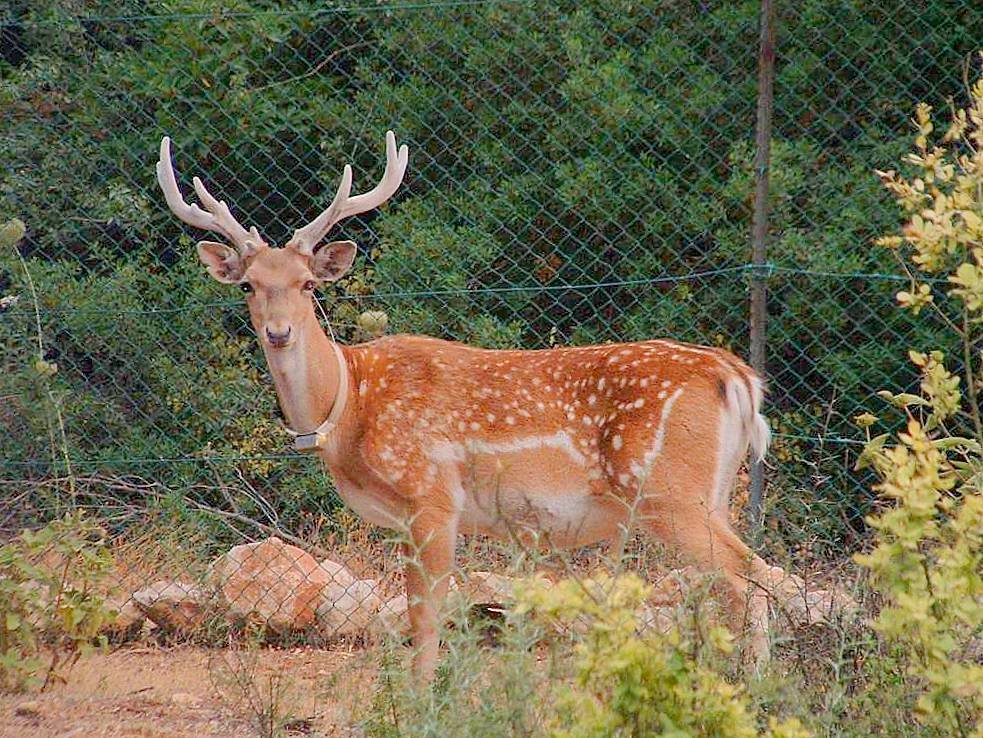Persian Fallow Deer

The Persian Fallow Deer (Dama dama mesopotamica) is a rare ruminant mammal belonging to the family Cervidae. Its taxonomic status is disputed, with some maintaining it as a subspecies of the Fallow Deer, while other treat it as a separate species, Dama mesopotamica.
The Persian fallow deer differ from their European counterparts in one very prominent characteristics. The European males have palmate antlers which are their 'trademark'. By contrast the Mesos have regular tines. How tis is known, not from the few animals left in Iran in the wild, after all this small nucleus represents a very small fraction of an entire population spread throughout the fertile crescent. As such, the animals existing today may just be a morph. However, there is documentation.
The picture below is a mosaic floor from an old synagogue in the ancient town of Zipori in northern Galilee in Israel, dating back to the year 400 AD. In this beautiful work of art, a leopard is depicted taking down a fallow deer (as is evident by the white spots.)
Persian fallow deer are bigger than Fallow Deer, their antlers bigger and less palmated. Actually the Persian fallow deer is the largest of the fallow deer, weighing 40-100 kg (90 - 220 lb.). It occupies woodland habitat. The diet of fallow deer varies by season and includes grass, nuts and leaves. Fallow deer live in herds, with males establishing territories during the breeding season.
The Persian fallow deer previously occurred in North Africa from the Tunisian border to the Red Sea and in Asia from Syria and Jordan to Iraq and western Iran. It was hunted to extinction over most of its range, with the advent of modern firearms having accelerating this process. By 1951 it was thought to have become extinct, but in 1955 a limited number were found in a dense forested region in Iran, near the border with Iraq. This population persisted despite continued hunting and habitat destruction at least until the 1980's. Recently, conflict between Iran and Iraq has made it difficult to determine the deer's status.
Habitat
The Persian fallow deer occupies a range of woodlands, such as tamarisk, oak andpistachio woodlands. The wild population utilizes riparian forest thickets.
Food
The Persian fallow deer is principally a grazer, with grass accounting for over 60% of its diet in summer. In the fall the proportion of fruits such as nuts increases. In the winter, the fallow deer browses on leaves.
Current Condition
For now, they are nearly extinct today, inhabiting only a small habitat in Khuzestan, southern Iran, two rather small protected areas in Mazandaran (northern Iran), an island in Lake Urmia in north-western Iran, and in some parts of Iraq and Israel. They were formerly found from Mesopotamia and Egypt to the Cyrenaica and Cyprus. The existing population may be suffering from inbreeding and lack of genetic diversity. Persian Fallow Deer had been considered extinct in 1951, before a small population was discovered in Khuzestan. About 365 animals are estimated to represent the world population.
Reproduction and Group structure
The Persian fallow deer lives in herds. During the breeding season the males establish territories. The rut is during August and early September, and calving at the end of March to early April, following a gestation period of approximately 229 days.
.....
.....
.....

.jpg)



























